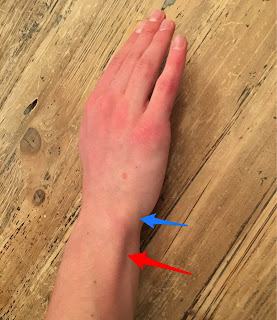1) Hook of the hamate fracture. The hamate bone is on the pinky side of the wrist and can cause pain and ultimately can break in any racquet or stick sport. Baseball players are most at risk. We believe that the pressure from the baseball bat exerts a force on this unusually shaped bone. Over time, pain can develop but initially it might be minor for some patients. But once the bone breaks, more significant pain develops. If not treated over months or years, other problems can develop related to nearby structures including flexor tendons and the ulnar nerve.
There are few reasonable treatment options for a hook of the hamate fracture. While casting can be considered, healing of the bone is unpredictable. Therefore, for most players, this small piece of bone is simply removed. Surgery is generally safe and return to play can be as soon as 6-8 weeks although in some players, it will take longer.
 |
| The blue arrow points to the location of the hook of the hamate and this is also the most common site of pain. \ |
Treatment of TFCC injuries begins with anti inflammatory medication and immobilization. Ideally a cast or rigid splint is worn for 6 weeks in an attempt to calm the wrist pain. If the player is unwilling to 'shut it down' there are other types of splints that can be worn, including a wrist widget. A failure to improve may lead to consideration of a steroid injection and, on occasion, wrist arthroscopy for a clean- up procedure or repair.
3) The 3rd common cause of pain on the pinky side of the wrist in baseball players is tendonitis of the extensor carpi ulnaris (ECU tendon). This typically begins with minor pain that can extend up and down the forearm. Over time, it can become sharp pain. The pain is often worse with certain wrist motions (extension, ulnar deviation, rotation). Rarely, with a sharp twisting injury, the tendon can slide out of its groove and pop in and out of place. This is a more severe injury.
Treatment also begins with anti inflammatory medications and rest. A hard cast or splint is ideal but, again, the wrist widget type of splint can also be helpful. Rarely a steroid injection may be necessary or even less commonly, surgery may be required.
 |
| The red arrow points to the typically location of ECU tendonitis. The blue area points to the area of pain with a TFCC injury. |
 |
| The red arrow points to the typically location of ECU tendonitis. The ECU tendon stands out. The blue area points to the area of pain with a TFCC injury. |
Charles A. Goldfarb, MD
My Bio at Washington University